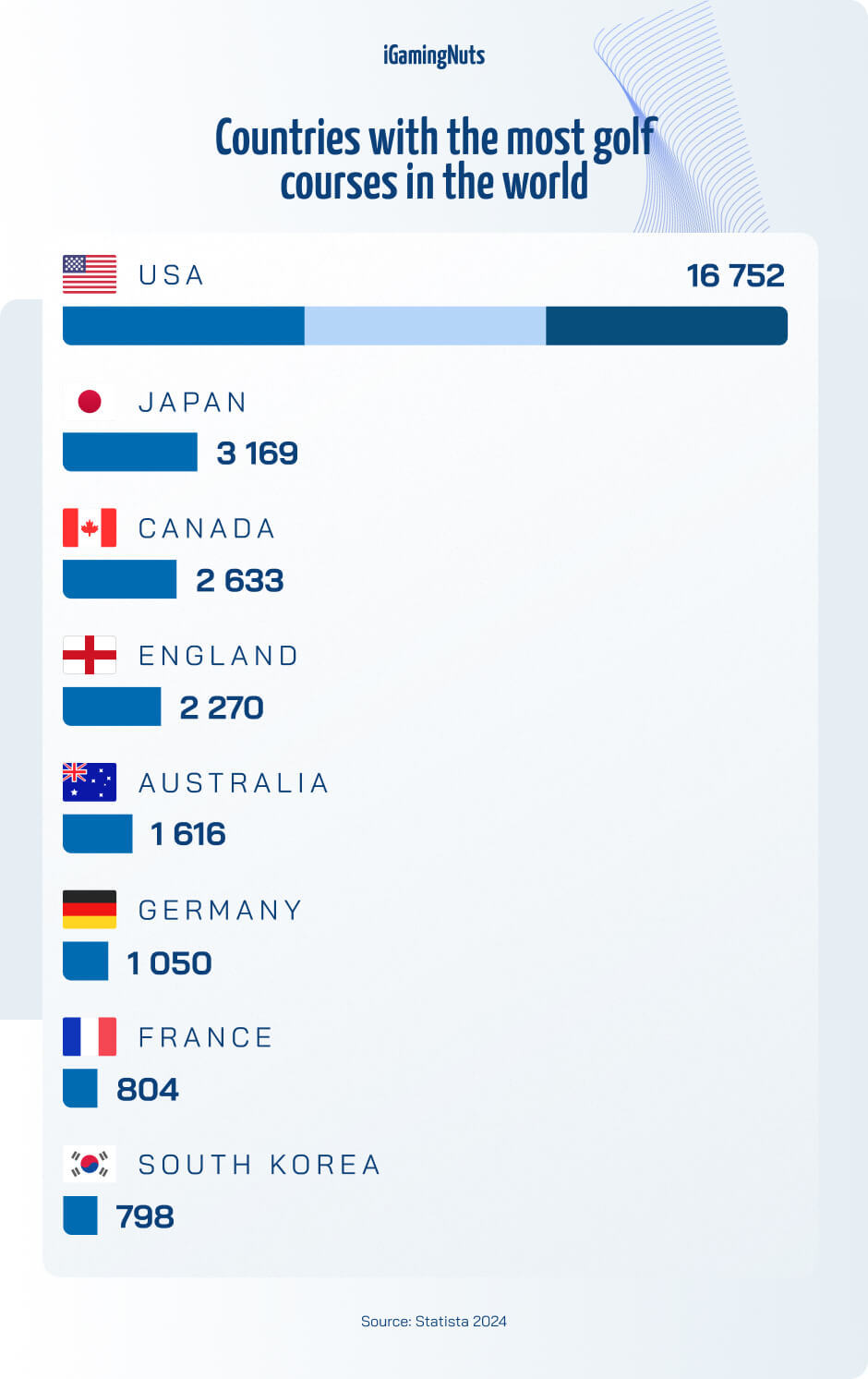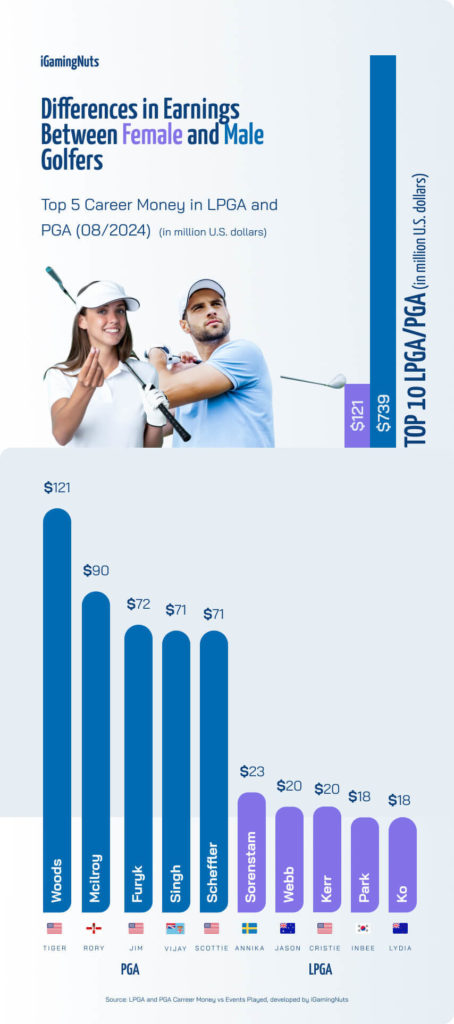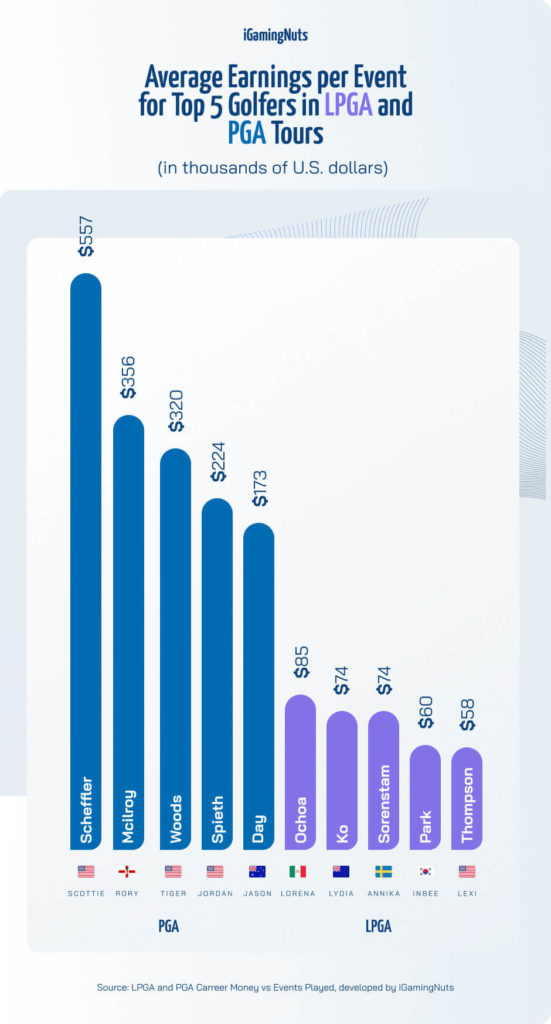Professional Female Golfers: Why You Haven’t Heard of Them Yet, and Why You Should?
Scotland is considered the cradle of modern golf, where the first major golf tournament took place in 1860. To this day, golf enjoys significant popularity both as a professional sport and a recreational activity. However, there are some differences in the perception of men’s and women’s golf. In 2023, over 26 million people in the United States played golf. The number of women and girls on the course has grown by 23% since 2018. Despite this significant increase, why is there still relatively little talk about professional female golfers?
Wider golf sphere
There are many reasons why people play golf. It is both a great form of relaxation and a balanced competition supported by skill. Golf can be enjoyed both on the course and off the course, each offering different experiences and activities. On-course golf refers to the traditional form of the game, where players compete on a full-length course, typically consisting of 18 holes. This format demands skill, strategy, and physical endurance as players navigate various terrains, weather conditions, and distances to achieve the lowest possible score.
Off-course golf, on the other hand, encompasses a variety of more casual and accessible forms of the game that can be enjoyed in different settings. These include activities like adventure golf (also known as mini-golf), where players putt on themed, smaller courses with obstacles; driving ranges, where players practice their swings by hitting balls into open fields; and pitch and putt, which is a shorter form of the game played on smaller courses designed for short strokes. These off-course activities are often less formal and cater to a wider range of skill levels, making golf more accessible to the general public.
Barriers to Professional Golf
According to the Golf for All Report 75% of golfers on the course are men. However, the gender distribution among golfers off the course is nearly equal: exactly 47% are women, and 53% are men. This isn’t a niche activity – about 12.9 million people engage in adventure golf, 4.8 million visit driving ranges, and 3.9 million enjoy pitch and putt golf.
Although the growing number of casual golf players suggests a broadening appeal of the sport, the transition to professional golf remains limited. The main reason why casual golf enthusiasts do not consider turning professional is the relatively closed and elite environment of professional golf. Journalist and golf enthusiast Genelle Aldred, in her column for Golf Business Quarterly, noted that sometimes the rules and approach towards new players are far from helpful and patient.
In golf tradition and etiquette are very important and need to be thoroughly understood and followed, for example the dress code that applies to everyone. Indeed, many of us associate professional golf with an elite sport for wealthy individuals.
Same Rules, Less Recognition
The rules of professional golf tournaments are identical for both women and men. There are no deviations or changes as is often the case in other sports. From time to time, the PGA Tour and LPGA Tour organize special tournaments and events where both men and women compete directly against each other. An example is the “Battle at Bighorn,” which took place in 2001 and was the first televised tournament where men and women competed head-to-head.
There are also other Mixed Open tournaments that bring together players of both genders, allowing them to compete on the same golf courses under equal conditions. In June 2022, Linn Grant achieved a historic feat by becoming the first woman to win a tournament on the DP World Tour. She triumphed at the Volvo Car Scandinavian Mixed with a nine-stroke lead over Henrik Stenson and Marc Warren.
Outstanding female golfers
In fact, there are many outstanding female golfers worth mentioning. Swedish golfer Annika Sörenstam began her professional career in 1992 and is considered the greatest female professional golfer in history. She has 10 major victories and 72 wins on the LPGA Tour. Sörenstam is also the first woman since 1945 to play in a PGA Tour event for men.
Lorena Ochoa, the Mexican golfer who dominated the world rankings from 2007 to 2010, must not be overlooked either. With 27 LPGA Tour victories, including 2 major wins, and 158 weeks at the top of the world rankings, she makes a strong impression!
Also, Korean golfer Inbee Park must be included in this esteemed group. She started playing golf at age 10 and quickly moved to the United States to continue her golf career. In 2007, she became an LPGA Tour player and had her first professional success only a year later in 2008 when she won the U.S. Women’s Open as the youngest player in history. Her achievements also include 7 major victories and a gold medal at the Rio de Janeiro Olympics in 2016. Inbee Park became the first golfer since Patty Berg in 1950 to win three major tournaments in one season. Notably, in men’s golf, Ben Hogan also achieved this rare feat in 1953. These accomplishments highlight the exceptional nature of Park’s success and secure her legacy in golf history.
Golf Around the World: Where Are the Professional Female Golfers?
As The R&A’s Golf Around the World statistics show, the top 10 countries have 78% of the world’s golf courses: the United States, Japan, Canada, England, Australia, Germany, France, South Korea, Sweden, and Scotland. While the presence of these countries on the list may not be surprising, what stands out is that the USA alone holds 43% of all golf courses globally. With 16,752 locations, it has over five times more courses than Japan, the next country on the list.

Given this, it’s not surprising that many professional female golfers come from the USA. Interestingly, participation in high school golf in the United States was 229 thousand (of which 40% girls) in the 2021/2022 school year, the highest number recorded since the beginning of the last decade. This shows a growing interest in golf as a sport, which is also by the fact that, according to the Global Consumer Survey by Statista (2022), 19.7% of Americans stated that they actively follow golf events. That percentage increased to 21% by March 2024, surpassing tennis and MMA.

The Earnings Disparity
If we look at the earnings statistics of professional female golfers on the LPGA Tour, according to 2021 data, female golfers from the United States earned a total of over $550 million. Korean golfers earned $224 million, surpassing Sweden in third place with earnings of only $73.6 million.
Considering the current top 10 places in the LPGA Career Money list, there are three US golfers who have earned a total of $49.4 million, which constitutes 28% of the top 10 earnings. Australian golfers Karrie Webb and Lydia Ko have earned a total of $38 million during their careers (22%). Two Koreans in this ranking (Inbee Park and Amy Yang) account for 20%, and Annika Sörenstam is fourth (22.6 million USD – 13%). Additionally, Suzann Pettersen from Norway has earned $14.8 million (9%), and Lorena Ochoa also accounts for 9%.
Professional Female Golfers vs. Male Golfers
When we look at the top 10 Career Money in the men’s competition the PGA – the first difference is the dominance of American players. 50% of the top 10 career earnings for men come from the United States, whereas in the women’s ranking, this percentage is 30%, indicating a greater national diversity among the top-earning female golfers.

The ranking results mainly highlight a significant disparity in earnings between men and women playing professional golf. Tiger Woods alone earned $121 million in his career. This is over 15% of the total amount for the top ten career earnings of professional male golfers, which is $739 million. In second place is Rory McIlroy from the UK with $90.4 million (12%), and third is Jim Furyk from the USA with $71.5 million (9.7%). What conclusions can we draw from this?
- The top-earning female golfer, Annika Sörenstam, earned almost 82% less than Tiger Woods—$22.6 million compared to $120.1 million.
- Tiger Woods’ earnings account for 70% of all earnings by the top 10 female golfers on the LPGA ranking.
- The top 10 female golfers earned less than 24% of what the top 10 male golfers earned ($173.5 million versus $739.2 million).
Breaking Down the Earnings Gap: A Closer Look
When we look at average earnings per event, the ranking of top golfers changes, though the gender gap remains evident.
Scottie Scheffler leads the pack, having played 127 events and earned over $70 million, averaging more than $550,000 per event. Following him is Rory McIlroy, who has participated in 254 events, with an average earning of over $350,000 per event. Tiger Woods, despite having the highest overall career earnings, ranks next with an average of $320,000 per event across 378 events.
On the women’s side, the highest average earnings per event belong to Lorena Ochoa. She played 175 tournaments and earned an average of nearly $85,000 per event. This is still less than the tenth-ranked male player, Matt Kuchar, who has played 556 events with an average of $107,000 per event. Lydia Ko, from Australia, has played 239 events, earning $74,000 per event, and Annika Sörenstam follows closely, having played 307 events with an average of $73,000 per event.

The Highest Prizes for Female and Male Golfers
These numbers highlight the significant gap in earnings, not just in total career winnings but also in average earnings per event, between male and female golfers. The amounts are not even close to each other. The highest prize for winning a golf tournament was awarded at The Players Championship 2023, where Scottie Scheffler received $4.5 million. The Players Championship, known as the “fifth major,” has one of the largest prize pools in professional golf, and winning this tournament is one of the most lucrative in golf history.
Another significant tournament in terms of prize money is the Tour Championship as part of the FedEx Cup Playoffs. In 2023, Viktor Hovland won the Tour Championship, earning $18 million from the FedEx Cup prize pool, although it is worth noting that this was the total sum for winning the entire cycle, not just a single tournament.
In women’s golf, the highest prize money for a single tournament victory was awarded at the U.S. Women’s Open 2023, where Allisen Corpuz received $2 million. This was the highest prize in the history of women’s golf for a single tournament win. It is worth noting that before 2022, these prizes were significantly lower. For example, Yuka Saso, the winner of the U.S. Women’s Open 2021, received $1 million, and in 2022 Minjee Lee received $1.8 million. These amounts reflect the dynamic growth of prize money, underscoring the increasing prestige of this event on the LPGA calendar.
The Future of Professional Female Golfers
The trend of rising prize money in women’s golf reflects broader changes in the entire women’s sports sector, where dynamic growth is observed. According to PwC’s Global Sports Survey 2022 results, over 35% of industry experts predict that the women’s sports sector will grow by 15-30% annually over the next three to five years. This growth is driven mainly by sports broadcasters, media companies, and the organizers of leagues and sporting events, who play a crucial role in the development of this discipline.
Moreover, increasingly frequent mixed-gender competitions offer a promising path toward equalizing earnings between the sexes. Equal rules of play for both genders can provide a solid foundation for further equality in prizes and the popularity of sporting events, including golf. Despite these positive changes, there is still a gap between the highest prizes in men’s and women’s tournaments, which, however, may change with the growing interest and investment in women’s sports.
I would also mention the report: Interests, Passions, and Hobbies of the Wealthy 2021 by Wealth-X. It turns out that sports and philanthropy are the two most popular interests among wealthy people. The most popular sport is golf, followed by skiing and tennis. Wealthy investors can support the development and media visibility of women’s golf in various ways. For example, investing in organizing women’s golf tournaments increases its visibility and attracts more media attention. They can also support mixed tournaments where men and women compete together, promoting gender equality. Very wealthy individuals might finance marketing campaigns that promote women’s golf through social media, television, and other communication channels. They could also engage in creating content, such as documentaries and films, that showcase the success stories of female golfers.
The Importance of Promoting Professional Female Golfers
Professional female golfers, despite their outstanding achievements, often find themselves overshadowed by their male counterparts. This disparity is driven by several factors, including significantly less media coverage, disparities in prize money, and limited exposure of women’s golf tournaments. These issues are compounded by historical biases and societal perceptions that continue to position golf as a predominantly male sport.
Yet, women’s golf is home to incredibly talented players like Annika Sörenstam and Inbee Park, whose impressive records and numerous titles demonstrate the high caliber of competition within the sport. Unfortunately, these remarkable athletes often receive far less attention, with their accomplishments going underreported compared to those of their male peers.
Promoting women’s golf is not only vital for achieving gender equality in sports but also for inspiring future generations of young female golfers. Increasing investment in women’s tournaments, enhancing media visibility, and garnering more support from sponsors are essential steps that can help bridge the gap between men’s and women’s golf. By focusing on these efforts, the disparity in recognition and earnings between female and male golfers can be gradually reduced.
Recognizing and supporting professional female golfers is important not just for the sport itself but for society at large. Promoting equality in sports helps challenge stereotypes, fosters a more inclusive culture, and ensures that talent is recognized and rewarded regardless of gender. In doing so, society benefits by encouraging diversity and empowering women to pursue excellence in all fields, including those traditionally dominated by men.
